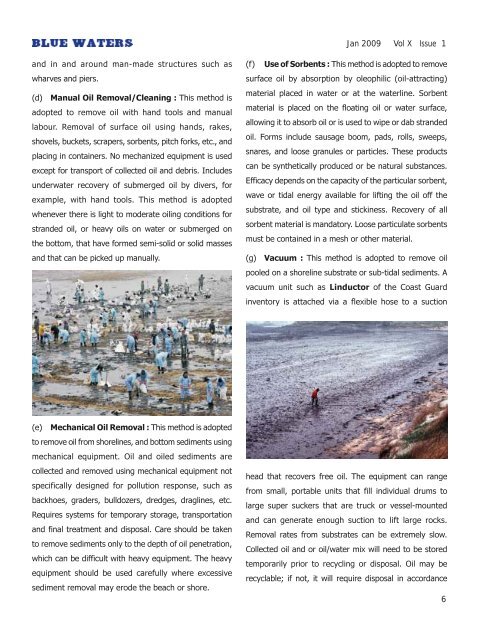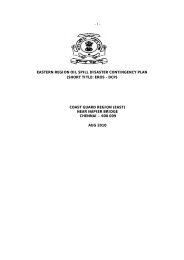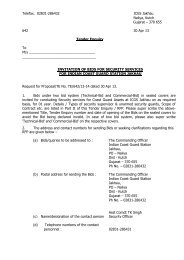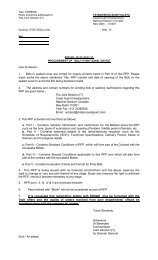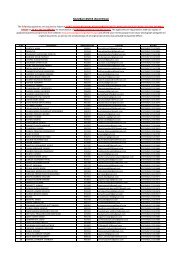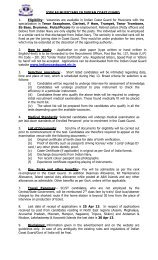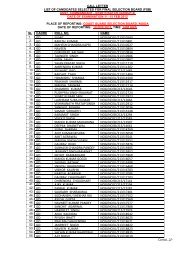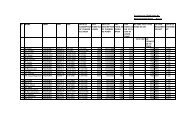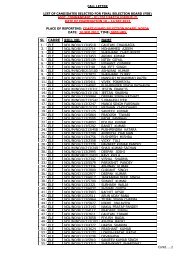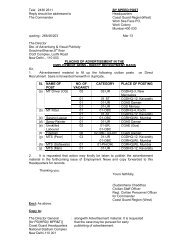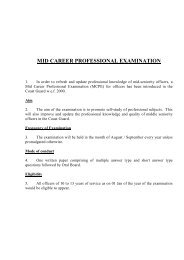Jan 2009 edition - Indian Coast Guard
Jan 2009 edition - Indian Coast Guard
Jan 2009 edition - Indian Coast Guard
You also want an ePaper? Increase the reach of your titles
YUMPU automatically turns print PDFs into web optimized ePapers that Google loves.
<strong>Jan</strong> <strong>2009</strong> Vol X Issue 1<br />
and in and around man-made structures such as<br />
wharves and piers.<br />
(d) Manual Oil Removal/Cleaning : This method is<br />
adopted to remove oil with hand tools and manual<br />
labour. Removal of surface oil using hands, rakes,<br />
shovels, buckets, scrapers, sorbents, pitch forks, etc., and<br />
placing in containers. No mechanized equipment is used<br />
except for transport of collected oil and debris. Includes<br />
underwater recovery of submerged oil by divers, for<br />
example, with hand tools. This method is adopted<br />
whenever there is light to moderate oiling conditions for<br />
stranded oil, or heavy oils on water or submerged on<br />
the bottom, that have formed semi-solid or solid masses<br />
and that can be picked up manually.<br />
(f) Use of Sorbents : This method is adopted to remove<br />
surface oil by absorption by oleophilic (oil-attracting)<br />
material placed in water or at the waterline. Sorbent<br />
material is placed on the floating oil or water surface,<br />
allowing it to absorb oil or is used to wipe or dab stranded<br />
oil. Forms include sausage boom, pads, rolls, sweeps,<br />
snares, and loose granules or particles. These products<br />
can be synthetically produced or be natural substances.<br />
Efficacy depends on the capacity of the particular sorbent,<br />
wave or tidal energy available for lifting the oil off the<br />
substrate, and oil type and stickiness. Recovery of all<br />
sorbent material is mandatory. Loose particulate sorbents<br />
must be contained in a mesh or other material.<br />
(g) Vacuum : This method is adopted to remove oil<br />
pooled on a shoreline substrate or sub-tidal sediments. A<br />
vacuum unit such as Linductor of the <strong>Coast</strong> <strong>Guard</strong><br />
inventory is attached via a flexible hose to a suction<br />
(e) Mechanical Oil Removal : This method is adopted<br />
to remove oil from shorelines, and bottom sediments using<br />
mechanical equipment. Oil and oiled sediments are<br />
collected and removed using mechanical equipment not<br />
specifically designed for pollution response, such as<br />
backhoes, graders, bulldozers, dredges, draglines, etc.<br />
Requires systems for temporary storage, transportation<br />
and final treatment and disposal. Care should be taken<br />
to remove sediments only to the depth of oil penetration,<br />
which can be difficult with heavy equipment. The heavy<br />
equipment should be used carefully where excessive<br />
sediment removal may erode the beach or shore.<br />
head that recovers free oil. The equipment can range<br />
from small, portable units that fill individual drums to<br />
large super suckers that are truck or vessel-mounted<br />
and can generate enough suction to lift large rocks.<br />
Removal rates from substrates can be extremely slow.<br />
Collected oil and or oil/water mix will need to be stored<br />
temporarily prior to recycling or disposal. Oil may be<br />
recyclable; if not, it will require disposal in accordance<br />
6


